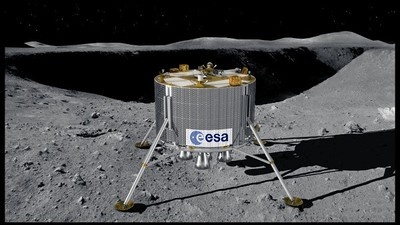Goal To Explore Moonscape, Test New Technology, Prepare
For Future Human Landings
 The first mission to visit the south polar region
of the moon took a significant step forward this week when the
European Space Agency signed a contract with EADS-Astrium in
Berlin, Germany
The first mission to visit the south polar region
of the moon took a significant step forward this week when the
European Space Agency signed a contract with EADS-Astrium in
Berlin, Germany
The ESA's lunar lander mission aims to land in the mountainous
and heavily cratered terrain of the lunar south pole in 2018. The
region may be a prime location for future human explorers because
it offers almost continuous sunlight for power and potential access
to vital resources such as water-ice.
To reach the surface safely, the lander must precisely navigate
its way to a mountain peak or crater rim, carefully avoiding
boulders and steep slopes before gently setting down to take in one
of the most spectacular views in the solar system.
The moon is a favored target for the human exploration missions
outlined in the "Global Exploration Strategy" by 14 space agencies
around the world. The strategy supports international space
exploration and calls for further studies of the moon and Mars -
places where humans may one day live and work.
The contract was signed by Simonetta Di Pippo, ESA's Director of
Human Spaceflight, and Michael Menking of EADS-Astrium, in the
presence of Peter Hintze, Parliamentary State Secretary in the
German Federal Ministry of Economics and Technology.
"It is a great pleasure to see progress being made in Europe in
the field of space exploration relying on key technologies
developed for human spaceflight," affirmed Di Pippo.
"As we prepare ourselves to join the US, Russia and Japan in the
decision to utilize the International Space Station for 10 more
years and beyond," she added, "we are preparing the next steps and
we are working to position Europe at the level of its competences
and capabilities within the global exploration undertaking.
"With a strong and successful presence in low orbit, the Moon is
the next natural goal on our common path to further
destinations.
"Europe is actively and successfully present in these global
projects, like ISS and exploration, which contribute to affirm our
role as a modern, dynamic and innovation-driven continent."
"The proven capabilities of the Automated Transfer Vehicle as a
technology demonstration are representative of Astrium's skills and
experience in automated rendezvous and docking procedures," stated
Dr Menking, Astrium's Senior Vice President Orbital Systems and
Space Exploration.

ESA Lunar Lander File Photo
"The concept of the new study is based
on the technologies of ATV and this unique expertise will enable us
to develop the key technologies; it would not be possible to
envisage landing a robotic vehicle on the Moon without them."
The start of the Phase-B1 study is an
important milestone because now, after the preliminary planning and
feasibility studies, the mission's design will be continued under
the leadership of EADS-Astrium Bremen and some of the key
technologies will be developed and tested for the first time.
First, the most recent topographic data covering the Moon's
south pole will be analyzed in detail to find the promising landing
sites. The target area is poorly understood and only now are we are
beginning to receive the information needed to consider landing and
operating a mission there.
Then, the robotic lander will be designed down to the level of
its various subsystems, such as propulsion and navigation.
The contract will culminate in a 'Preliminary System
Requirements Review' in 2012, which will provide the basis for the
final design of the mission and lander.
 TikToker Arrested After Landing His C182 in Antarctica
TikToker Arrested After Landing His C182 in Antarctica Classic Aero-TV: Versatile AND Practical - The All-Seeing Aeroprakt A-22 LSA
Classic Aero-TV: Versatile AND Practical - The All-Seeing Aeroprakt A-22 LSA ANN's Daily Aero-Term (06.27.25): Hazardous Weather Information
ANN's Daily Aero-Term (06.27.25): Hazardous Weather Information ANN's Daily Aero-Linx (06.27.25)
ANN's Daily Aero-Linx (06.27.25) Aero-News: Quote of the Day (06.27.25)
Aero-News: Quote of the Day (06.27.25)




